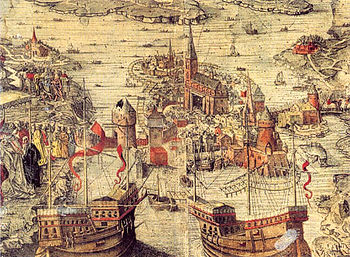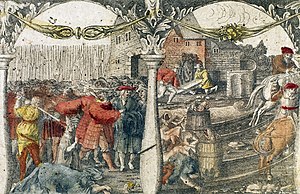Stockholm Bloodbath

TheStockholm Bloodbath(Swedish:Stockholms blodbad;Danish:Det Stockholmske Blodbad) was atrialthat led to a series of executions inStockholmbetween 7 and 9 November 1520. The event is also known as theStockholm massacre.[1]
The events occurred after the coronation ofChristian IIas the newking of Sweden,[2]when guests in the crowning party were invited to a meeting atTre Kronorcastle. ArchbishopGustav Trolle,demanding economic compensation for things such as the demolition ofAlmarestäket's fortress,questioned whether the former Swedish regentSten Sture the Youngerand his supporters had been guilty ofheresy.Supported bycanon law,nearly 100 people[3]were executed in the days following the meeting despite promises of amnesty. Among those killed were many people from the aristocracy who had been supporting theSture Partyin the previous years. Thereafter King Christian II became known in Sweden asKristian Tyrann( "Christian [the] Tyrant" ).
Background[edit]
Political factions in Sweden[edit]
The Stockholm Bloodbath was a consequence of conflict between Swedish pro-unionists (in favour of theKalmar Union,then dominated by Denmark) and anti-unionists (supporters of Swedish independence), and also between the anti-unionists and the Danisharistocracy,which in other aspects was opposed to King Christian.[4]The anti-unionist party was headed bySten Sture the Younger,and the pro-unionist party by theArchbishopGustavus Trolle.[citation needed]
Military interventions of King Christian[edit]
King Christian, who had already taken measures to isolate Sweden politically, intervened to help Archbishop Trolle, who was undersiegein hisfortressatStäket.However, he was defeated by Sture and his peasant soldiers atVedila,and forced to return to Denmark. A second attempt to bring Sweden back under his control in 1518 was also countered by Sture's victory atBrännkyrka.Eventually, a third attempt made in 1520 with a large army ofFrench,GermanandScottishmercenariesproved successful.[5]
Sture was mortally wounded at theBattle of Bogesundon 19 January 1520. The Danish army, unopposed, was approachingUppsala,where the members of the SwedishRiksdag of the Estateshad already assembled. The senators agreed to render homage to Christian, on condition that he give a fullamnestyfor past actions and a guarantee that Sweden should be ruled according to Swedish laws and customs. A convention to this effect was confirmed by the king and the DanishPrivy Councilon 31 March.[5]Sture's widow,Lady Kristina,was still resisting inStockholmwith support from the peasants of central Sweden, and defeated the Danes at Balundsås on 19 March. Eventually, her forces were defeated atUppsala(långfredagsslaget vid Uppsala) on Good Friday, 6 April.[6]
In May, the Danish fleet, led by King Christian, arrived andStockholm was attackedby land and sea. Lady Kristina resisted for four months longer, and in the beginning of autumn Kristina's forces began winning. The inhabitants of Stockholm had a large supply of food and fared relatively well. Christian realized that his stockpile was dwindling and that it would doom his army to maintain the siege throughout the winter. With the help ofBishop Mattias,Hemming Gadh and other Swedes of high stature, Christian sent a proposal for retreat that was very advantageous for the Swedes. During a meeting on what is thought to be Beckholmen, outside ofDjurgården,Christian swore that all acts against him would be forgotten, and gave pardon to several named persons (includingGustav Vasa,who had escaped from Denmark, where he had been held hostage). Lady Kristina would be given Hörningsholm and all Mörkön as afief,and was also promisedTavastehusinFinland.When this had been written down on paper, the mayor of the city delivered the keys to the city onSödermalmand Christian held his grand entry. Shortly after, he sailed back to Denmark, to return in October for his coronation.[7]
Massacre[edit]

On 4 November, Christian wasanointedbyGustavus TrolleinStorkyrkan Cathedraland took the usualoathto rule the kingdom through native-born Swedes only.[5]Abanquetwas held for the next three days. Lots of wine and beer was drunk and jokes were cracked between Danes and Swedes.[8]
On the evening of 7 November, Christian summoned many Swedish leaders to a private conference at the palace. At dusk on 8 November, Danish soldiers, with lanterns and torches, entered a great hall of the royal palace and imprisoned several noble guests. Later in the evening, even more of the king's guests were imprisoned. All these people had previously been marked down on Archbishop Trolle'sproscriptionlist.[5]
The following day, 9 November, a council, headed by Archbishop Trolle, sentenced the proscribed todeathfor beingheretics;the main point of accusation was their having united in a pact to depose Trolle a few years earlier. However, many of them were also leading men of the Sture party and thus potential opponents of the Danish kings. At noon, the anti-unionistbishopsofSkaraandSträngnäswere led out into thegreat squareandbeheaded.Fourteen noblemen, threeburgomasters,fourteen towncouncillorsand about twenty common citizens of Stockholm were thenhangedor beheaded.[5]
The executions continued throughout the following day (10 November).[5]According to the chief executioner, Jörgen Homuth, 82 people were executed.[9]It has been claimed that Christian also took revenge on Sten Sture's body, having it dug up and burnt, as well as the body of his child.[5]Sture's widowLady Kristinaand many other noblewomen were taken as prisoners to Denmark.[10]
Aftermath[edit]
Christian justified the massacre in a proclamation to the Swedish people as a measure necessary to avoid a papalinterdict,but, when apologising to thePopefor the decapitation of the bishops, he blamed his troops for performing unauthorised acts ofvengeance.[5][11]
Gustav Vasawas a son ofErik Johansson,one of the victims of the executions. Vasa, upon hearing of the massacre, travelled north to the province ofDalarnato seek support for a new revolt. The population, informed of what had happened, rallied to his side. They were ultimately able to defeat Christian's forces in theSwedish War of Liberation.The massacre became the catalyst that permanently separated Sweden from Denmark.[12]
Later reception and propaganda[edit]
The Stockholm Bloodbath precipitated a lengthy hostility towards Danes in Sweden, and from then on the two nations were almost continuously hostile toward each other. These hostilities, developing into a struggle forhegemonyin the Scandinavian and North German area, lasted for nearly three hundred years. Memory of the Bloodbath served to let Swedes depict themselves (and often, actually regard themselves) as the wronged and aggrieved party, even when they were the ones who eventually took the political and military lead, such as the conquest and annexation ofScaniauntil theTreaty of Roskildein 1658.[13]
Christian the Tyrant and spurious "Christian the Good"[edit]
The event earned Christian II the nickname ofKristian Tyrann(Christian [the] Tyrant) in Sweden, which is retained in the present day.[14]It is a common misconception in Sweden that King Christian II is given the contrary bynameChristian den Gode(Christian the Good) in Denmark, but this isapocryphal.[15]
According to Danish historians, no bynames have been given to Christian II in Danish historical tradition. In an interview with Richardson in 1979, Danish historianMikael Venge,author of the article about Christian II inDansk Biografisk Leksikonsaid: "I think you ought to protest the next time the Swedish radio claims anything so utterly unfounded that could be understood as if the Danes approved of the Stockholm bloodbath." Despite this, even today, tourist guides in Stockholm spice up their guiding of the Old Town (Gamla Stan) with the news about Christian II's "rehabilitation" back in Denmark.[16]
In fiction[edit]
The event is depicted in the 1901 novel,Kongens Fald(The Fall of the King), by Nobel LaureateJohannes V. Jensen.[17]The bloodbath forms a large part of the 1948historical novelThe Adventurer(original titleMikael Karvajalka) by theFinnishwriterMika Waltari.The events are depicted as seen by Mikael Karvajalka, a young Finn in Stockholm at the time.[18]A number of references to the Stockholm Bloodbath appear inFreddy's Book(1980) by American novelistJohn Gardner.[19]A 2005 bookBruden fra Gent(translated in Nl.De Gentse Bruid,orThe Bride From Ghent) by the Danish writerDorrit Willumsen,referenced these events. It illuminates the life of Christian II as seen from his relationship with his mistress, the DutchDyveke,and his wifeIsabella of Austria,sister ofCharles the Fifth.[citation needed].The event is also the subject of a 2023 film directed byMikael Håfström,also titledStockholm Bloodbath,which depicts the events withdark comedyovertones.[20]
See also[edit]
- Kalmar Union
- Sten Sture the Younger
- Swedish War of Liberation
- Sture Murders
- Åbo Bloodbath
- Linköping Bloodbath
References[edit]
- ^Usually called "Stockholm bloodbath" (nativelyStockholms blodbad), the event is also known as "Stockholm massacre" in English, so called in the English translation ofErik Gustaf Geijer'sSvenska folkets historia(1832–36), published in 1845 asThe History of the Swedes(p. 102).
- ^Lindqvist 1993, p. 13
- ^Stockholm BloodbathonNationalencyklopedin's website. Retrieved 8 January 2014.
- ^Jens Aage Poulsen (2007).Det Historiske Overblik(in Danish). Gyldendal Uddannelse. pp. 102–.ISBN978-87-02-05665-5.Retrieved6 July2013.
- ^abcdefghOne or more of the preceding sentences incorporates text from a publication now in thepublic domain:Bain, Robert Nisbet(1911). "Christian II.".InChisholm, Hugh(ed.).Encyclopædia Britannica.Vol. 6 (11th ed.). Cambridge University Press. pp. 274–276.
- ^Syse, Bent. (2003)Långfredagsslaget: en arkeologisk historia(Uppsala: Upplandsmuseets);ISBN91-85618-71-3
- ^Henrikson, Alf.(1966)Svensk Historia;ISBN91-0-047053-8[pages needed]
- ^Henrikson, Alf & Hasse Erikson (1979)Storkyrkan: en svensk krönika(Stockholm: Bonnier);ISBN91-0-042947-3
- ^Lars Ericson Wolke.Stockholms Blodbad,Stockholm 2006,ISBN9151843803p. 141
- ^Encyclopædia Britannica, Eleventh Edition,1911,Christian IIprofile,gutenberg.org; accessed 12 May 2015.
- ^Weibull, Lauritz.Nordisk historia. Forskningar och undersökningar. Del III. Från Erik den helige till Karl XII,Stockholm 1949, pp. 160–163.ISBN9968-04-746-5
- ^Hofverberg, Elin (9 November 2021)."The Stockholm Bloodbath of November 1520".Library of Congress - Blog.Library of Congress. Archived fromthe originalon 20 January 2022.Retrieved30 March2024.
- ^Frost, Robert I. (2000)The Northern Wars. War, State and Society in Northeastern Europe 1558–1721(Harlow: Pearson Education Limited);ISBN978-0-582-06429-4
- ^Bengt Liljegren (2004).Rulers of Sweden.Historiska Media. p. 67.ISBN978-91-85057-63-4.Retrieved6 July2013.
- ^Rikke Agnete Olsen (2004).41 fortællinger om folk i fædrelandets historie(in Danish). Lindhardt og Ringhof. p. 149.ISBN978-87-595-2373-5.Retrieved6 July2013.
- ^Gunnar Richardson,"Kristian II – Tyrann eller den gode?",Dagens Forskning,13 May 2002.[dead link]
- ^Dansk litteraturs historie: 1870–1920.Gyldendal A/S. 2009. pp. 672–.ISBN978-87-02-04184-2.Retrieved6 July2013.
- ^The New York Times Book Review.Arno Press. 1950. p. 9.Retrieved6 July2013.
- ^Book Review Digest.H.W. Wilson Co. 1980. p. 435.Retrieved6 July2013.
- ^Håfström, Mikael (2024-01-18),Stockholm Bloodbath(Action, History, War), Sophie Cookson, Alba August, Emily Beecham, Nordisk Film, Viaplay Studios,retrieved2024-01-22
Sources[edit]
- Wolke, Lars Ericson (2006)Stockholms blodbad(Stockholm: Prisma)ISBN91-518-4380-3
- Larsson, Lars-Olof (2003)Kalmarunionens tid, Bokförlaget Prisma(Stockholm: Andra upplagan)ISBN91-518-4217-3.
- Weibull, Lauritz(1949)Nordisk historia. Forskningar och undersökningar. Del III. Från Erik den helige till Karl XII,Natur & KulturStockholmISBN9968-04-746-5.
- Harrison, Dick(2002)Sveriges historia. Medeltiden(Stockholm: Liber)ISBN91-47-05115-9.
- Harrison, Dick(1997)Uppror och allianser. Politiskt våld i 1400-talets svenska bondesamhälle(Lund: Historiska institutionen);ISBN91-85057-37-1.
External links[edit]
- Stockholm Bloodbath
- Political history of Denmark
- History of Stockholm
- Political history of Sweden
- 1520 in Christianity
- 1520 in Sweden
- Conflicts in 1520
- 16th century in Stockholm
- 16th-century executions by Denmark
- Massacres in Sweden
- Persecution of Christian heretics
- 16th-century Catholicism
- Catholic Church in Sweden
- Denmark–Sweden relations
- Political and cultural purges
- Christian II of Denmark
